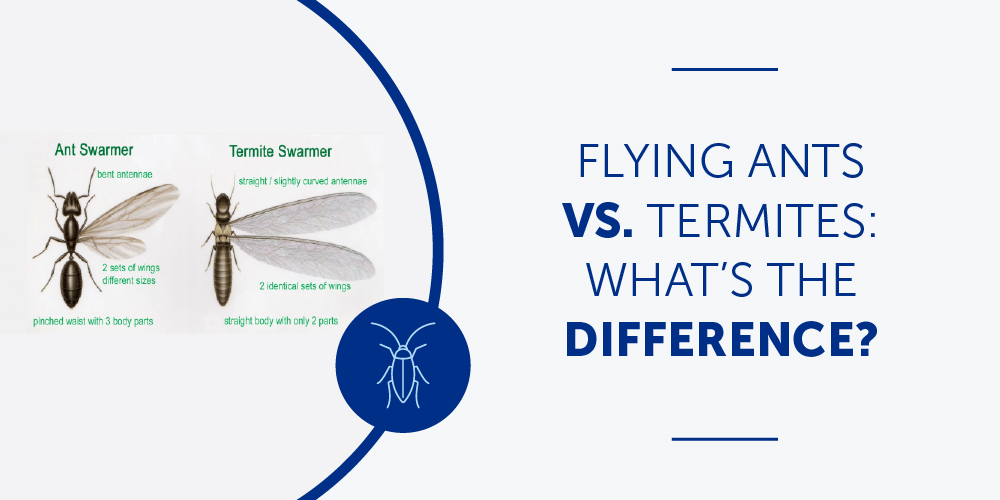Flying ants vs. termites: What to look for
Many people wonder about the difference between flying ants vs termites because both insects look very similar. Flying carpenter ants with wings, though, have a pinched waist, three distinct body sections, curved ("elbowed") antennae, and two sets of differently sized wings that are pointed: large front wings and smaller back wings.
Winged termites, also called swarmers, have straight antennae that are shorter than an ant's and look like they are made out of a bunch of tiny balls. Termites also have a straight, waistless body, and two sets of wings that are equal in length, rounded on the ends, and twice the size of their body. Termites fly (or swarm) in the spring when it's warm and rainy, while ants fly during the summer. When ant looking bugs with wings and termite swarmers mate, they lose their wings.
Flying Ants vs. Termites: Damage
The damage that bugs that look like ants with wings and termites leave behind can look alike at first glance, though there are some distinct differences that can be difficult to notice unless you know what to look for. Here are a few things that can help you determine which pest is bugging you:
Flying ants
- Carpenter ants do not actually eat wood (or materials like foam insulation); they prefer soft or rotted wood to create their tunnels and nest galleries by hollowing it out. Your home may have water damage if you have an ant infestation in your home, since leaking plumbing is a big attraction.
- When ants shed their wings, they can be found on windowsills, though remember their wings are of dissimilar size, so it’s another indication that you may have a problem with flying ants vs termites.
- A small pile of sawdust will be located just outside carpenter ant tunnels, which can be easily missed unless you’re on the lookout.
Flying termites
- Discarded termite wings can be found near closed windows and doors, too, though their wings are different from an ant’s. Termites also don’t actually shed their wings; they twist them off because they will never need them again when they mate.
- Pencil-sized mud tubes can be found wherever the ground meets your house or near any other possible food source, like a tree or shed.
- Wood damage is found below and behind surfaces like walls and floors, though a telltale sign can be tiny holes in walls with debris gathered around the holes.
Flying Ants vs. Flying Termites: Comparison Table
| Feature | Flying Ants | Flying Termites |
| Antennae | Elbowed | Straight |
| Body Shape | Pinched waist, three body sections | Straight, waistless |
| Wing Size | Larger front wings, smaller back wings | Equal-sized, rounded ends |
| Swarming Time | Summer, warm months | Spring, after warm rain |
| Feeding Habits | Nest in moist wood, don’t eat it | Consume wood (cellulose) |
| Damage | Minor, hollowing galleries | Significant structural damage |
| Signs of Infestation | Sawdust piles, wings of different sizes | Mud tubes, uniform discarded wings |
| Colony Size | Up to a few thousand | Up to millions |
| Wing Shedding | Natural shedding, uneven wings left behind | Twist off uniform wings |
| Flight Pattern | Fast, erratic | Slower, controlled |
| Habitat | Inside wood, under floors, or in walls | Damp wood, hidden walls, or underground |
| Lifecycle | Colonies live a few years | Colonies can live decades |
| Activity | Night or early morning |
Mostly daylight during swarms |
If you see these insects flying inside your home, you likely have an ant looking bug with wings or termite nest inside your home that must be treated immediately.
Termites prefer to hide, so if you see insects crawling around, they may be ants. Termites and ants don't hang out together, either, so you probably just have one or the other of these pests.
Stop in at any of Bug & Weed Mart's Valley-wide locations to see how we can help you get rid of flying ants, termites control, or any number of other pests.

